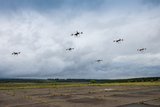Simulated near miss helps aircraft think like pilots
Researchers from British universities and industry have successfully tested technology that allows an unpiloted aircraft to autonomously detect and avoid collision with another aircraft, in an important step towards proving the safety of unmanned air vehicles.
The “sense and avoid” trial, which took place in the skies over North West England, involved two Jetstream passenger aircraft and was a convincing demonstration of how technology can replace the eyes and decision-making powers of a human pilot.
The research programme involved Cranfield and Lancaster Universities and BAE Systems, and was so successful it has just received a special award for “outstanding achievement” at The Engineer magazine’s Technology and Innovation Awards. The test flight used BAE Systems’ Jetstream Flying Test Bed airborne laboratory as a so-called surrogate unmanned air system, or UAS. Flying autonomously, the Jetstream encountered an “intruder” in the form of another Jetstream, and using advanced computer software and a range of sensors was able to determine its path and take the necessary evasive action to avoid collision.
“Sense and avoid is a critical capability for many UAS programmes and will be a key factor in opening the UK airspace to unmanned vehicles in the future,” said Nick Colosimo, a technical manager on the trial. “Using the Jetstream allows us to progress the necessary technology rapidly because we can adapt the trials ‘on the fly’. This type of research also further reduces the gap between synthetic experiments and real life UAS trials.”
The sense and avoid trial was conducted as part of BAE Systems’ centrally funded Capability Augmentation Programme (CAP), which uses studies, synthetic and live demonstrations to prove the concept of advanced technologies. CAP Manager Andy Wright said: “The ability to test and prove advanced technologies is essential if we are to deliver new capability to the armed forces rapidly. Programmes like this sense and avoid trial not only help develop vital technologies for unmanned vehicles, but also allow us to do it quickly and cost effectively.”
The technology developed will ultimately be integrated into future UASs such as the Mantis and Taranis technology demonstrators. An effective sense and avoid capability is also a key requirement of the ASTRAEA programme, which is a Government and industry funded programme addressing the technological and regulatory challenges of flying UASs in UK airspace.
More from Uncrewed Vehicles
-
![Ready for the race: Air separation drone swarms vs. air defence systems]()
Ready for the race: Air separation drone swarms vs. air defence systems
As the dynamics of aerial combat rapidly evolve, Chinese scientists have engineered a sophisticated air separation drone model that can fragment into up to six drones, each capable of executing distinct battlefield roles and challenging the efficacy of current anti-drone defences such as the UK’s Dragonfire laser system.
-
![Israel’s MALE UAVs ‘must adapt’ to Iranian-made air defences]()
Israel’s MALE UAVs ‘must adapt’ to Iranian-made air defences
Advancements in air defence technologies have begun to reshape aerial combat dynamics in the Middle East, as illustrated by recent events involving the Israeli Air Force and Hezbollah.
-
![Hundreds more UAS sent to Ukraine forces with thousands more on the way]()
Hundreds more UAS sent to Ukraine forces with thousands more on the way
Both sides of the Russia-Ukraine war have been using UAS for effective low-cost attacks, as well as impactful web and social media footage. Thousands more have now been committed to Ukrainian forces.
-
![AI and software companies selected for US Army Robotic Combat Vehicle subsystems]()
AI and software companies selected for US Army Robotic Combat Vehicle subsystems
The US Army has intentions to develop light, medium and heavy variants of the Robotic Combat Vehicle (RCV) as part of the branche’s Next Generation Combat Vehicle family.
-
![DroneShield to improve software of DroneSentry-X C-UAS system under new contract]()
DroneShield to improve software of DroneSentry-X C-UAS system under new contract
DroneSentry-X, a cross-vehicle compatible, automated 360° C-UAS detect and defeat device, can offer 360° awareness and protection using integrated sensors. According to its manufacturer, it is suitable for mobile operations, on-site surveillance and on-the-move missions.
-
![Ukraine takes delivery of new indigenous C-UAS systems]()
Ukraine takes delivery of new indigenous C-UAS systems
Funded by the country’s former president, the new C-UAS systems will be sent to the frontline where they have already been tested against Russian invading forces.


























